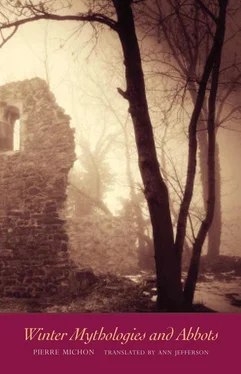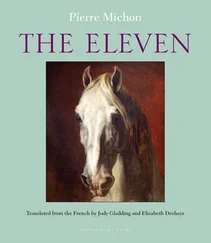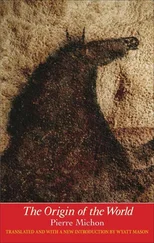He is on the Causse Méjan, at the southwest edge, just before the causse tips passionately down to the bed of the River Jonte, toward Saint-Pierre-les-Tripiés; he is on the site of the Cave of the Dead Man, which of course was named by him. It is autumn in 1871. The site is an ossuary in a rock shelter, which Prunières discovered in the spring of 1870; he dug it only once; he left little protection for it, thinking he would be back in a month or two. But war came, and with it the uhlans and sabers that perform excellent trepanations, and the gods who, when all is said and done, are lenient and will trade two years of famine for a brand-new republic. There have been two years of rain, frost, rodents, and landslips on the causse; when Prunières returns, half the ossuary has fallen into the gully.
It is autumn. Prunières has brought along Dr. Broca, president of the Anthropological Society of Paris (a man who knows us in his own particular way, though we do not know him: inside our skulls we each carry a cerebral convolution known as Broca’s area ). All day long they have assembled and named bones, like the gravedigger in Hamlet . They have placed them in two large crates that the curé of Saint-Pierre had carpentered for them. It’s the end of the day. Broca is tired and stands smoking a cigar outside the cave; he looks at the autumn, the troglodyte bones in the curé’s crate; he thinks about things and about the naming of things. Prunières is carrying out a final inspection of the gully before leaving. And there, three hundred meters farther down, he finds a very fine, very white humerus. At the same time as the bone, he finds the simple, beautiful sentence he will utter at the Bordeaux Anthropological Congress on September 12, 1872: “All the bones had been bleached white by the rain, the dew, and the snow.”
In December 1893, Dr. Prunières is returning in the depths of night after attending a birth on the Aubrac plateau. He is caught in a snowstorm. He struggles on for several hours — he has a strong constitution, hardened by handling suffering bodies and bodies that have ceased to suffer. Then he gives up the struggle and settles himself between three rocks like an old troglodyte. He says to himself, “I am going to die.” He repeats to himself, “Baumes-Chaudes Man, the troglodyte race, the dolmenic race, circular pieces of skull.” He says to himself that his body will not be found. Aloud, he says, “All the bones had been bleached white by the rain, the dew, and the snow.” The snow lays a maternal blanket over him.
He was still alive when he was found in the morning. He died during the day, from acute pulmonary edema.
Bishop Hilère has abandoned his miter. His beard is quite white. He has handed in his crozier. He has founded a community of brothers no one knows where on the banks of the River Tarn, doubtless on the spot where Énimie, the saint with Merovech’s blood, will later come.
Hilère is growing old. We know that he is growing old, but very little else is known about him. We know what he is not. He is not Hilary of Poitiers, who returned from beyond the grave to wield Clovis’s sword against Alaric at the Battle of Vouillé. He is not Hilary of Carcassonne, who was there on the day of Pentecost, backstage with Saint Sernin, and who consequently saw the tiny flames above the heads of the apostles, observed the apostles twirling and humming beneath the fire like girls dancing in a ring, was convinced that it was the truth which danced and blazed like this, and followed Saint Sernin to the Gauls, a bishopric, and martyrdom. He is not the Hilary of Padua whom Correggio painted from memory. Nor is he Hilarion of Gaza, friend of Saint Anthony, about whom Flaubert brazenly said he was the devil. Our Hilère is also well acquainted with the devil.
He has made a little hermitage for himself, halfway between the Tarn below and the Causse Sauveterre above, on the edge of the cliff, in the locality of Les Baumes. It is flat like the palm of a hand. It combines the advantages of a chasm with those of a desert. You’re in the dungeon of the universe, and yet on the top of the world: it’s a good hermitage. This is where Hilère comes more and more often to escape the chatter of the brothers, to talk within himself to that other person who is God, and also to talk within himself to the other person he once was, when his beard was black. And here, in this very long conversation with himself, the devil will sometimes appear.
For whole days at a time, he takes the harmless form of naked girls. At other times, he takes the form of Hilère himself, wearing a tiara on the seat of Saint Peter. And at other times still, he has no form at all, just a light wind, beautiful sunshine, and the lovely fresh leaves on the poplars along the Tarn, a moment of elation, or a desire to stretch one’s legs. “I’ll climb up to the edge of the causse,” says the hermit to himself.
It’s very slow going, with endless detours. The old man has to keep stopping.
He is on the causse. The wind blows over it like the Holy Spirit. It is infinite but definable, like the name of God which can be woven into three Persons. It is the open palm of Creation, holding up to God a tiny blessed figure leaning on his stick. The earth arose up by miracle by the will of Our Lord, in such wise that he sat as high as the other: it’s in the Scriptures and Hilère recalls it. He repeats the sentence to himself, and the wind blows over his heart. The wind plays with the trees. Perhaps it’s the wind speaking to him: What need have you of a miter? What need have you of Rome? This is your bishop’s seat. These are the seven hills, and God is directly overhead, with no one to stand between Hilère and Him. He is intoxicated with pride. He opens his arms, he runs, he’s a little out of breath — and Lord, how the sun has sunk; he must get back before night. He turns away from the causse, the throne of Saint Peter, the bare back of the earth where nothing grows: he thinks he sees a little old monk leaning on a stick and laughing. It’s only a juniper tree. “So it’s you, Satan,” he says reproachfully. He makes his way down as night falls. He can hear his miserly old man’s breath in the night. Bats fly past; it’s our own tiny heart beating up there. It’s the tiny black heart of the pope, of Hilère, or of the lowliest cowherd. No one knows. One man is all men, one place all places, thinks Hilère. He wonders whether this thought comes from God or the devil.
Énimie is the granddaughter of Fredegund, who had her rivals tied to horses’ tails. She is the daughter of Clotaire II, king of Paris, who, for as long as his mother was alive, did not reign, and who has scarcely dared to reign since her death. Énimie is fifteen years old.
Clotaire is waging war against the king of Metz and the king of Austrasia. The king of Austrasia wants peace; Clotaire summons Gondevald, mayor of the palace of Paris, who can read and is on good terms with the mayor of the palace of Metz. They draft a treaty. On the first page there is a list of the possessions that the king of Metz will hand over to the king of Paris if he returns his weapons to their sheaths.
Clotaire is satisfied with the possessions that Gondevald reads out from the parchment. There are many distant priories among them, for which abbots must be appointed — fictitious abbots who will never set foot in them but who will receive the benefices. Clotaire accordingly makes himself abbot three times over, little Dagobert his son twice, Gondevald four times, and the remainder go to his close allies and cousins: Sigisbert, Gontran, and Caribert. The mayor and the king laugh, and drinks are brought. They pick up the list again and have a momentary hesitation because the next name is that of a monastery for girls, and as Fredegund is dead they are uncertain whom to allocate it to. The shade of Fredegund passes between them. They drink without pleasure — then Gondevald smiles: “Énimie,” he says.
Читать дальше











